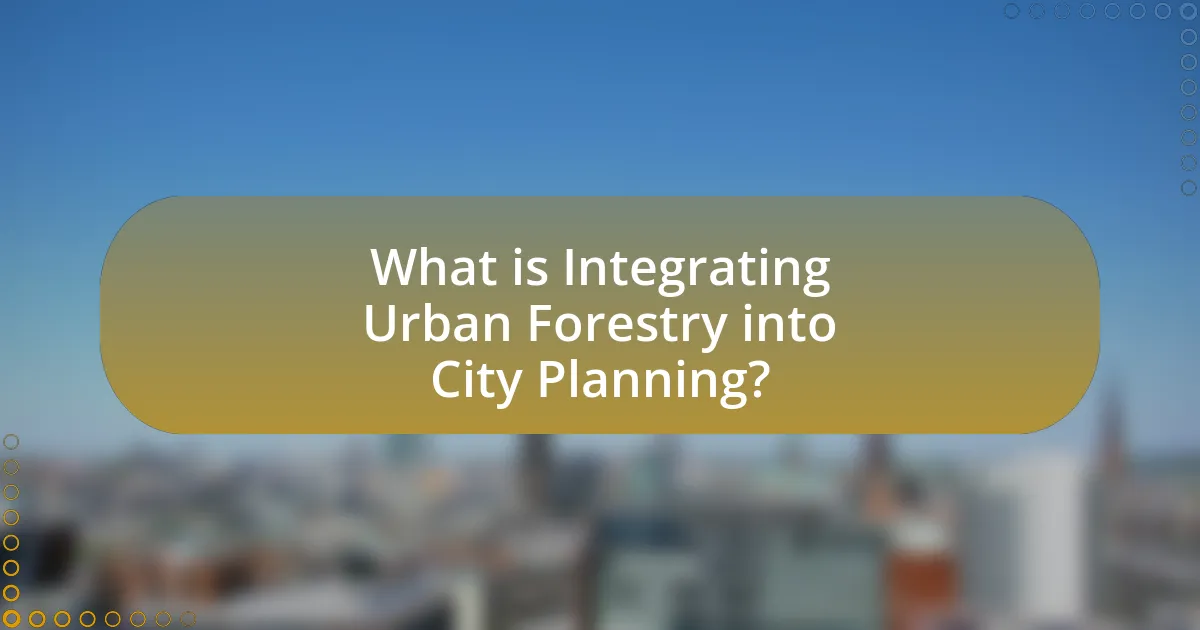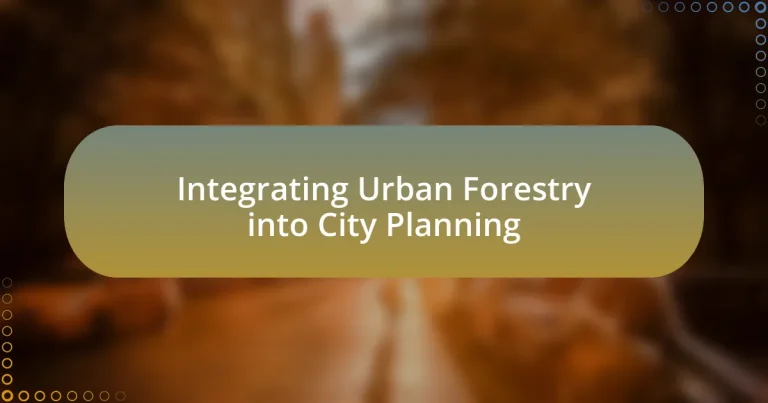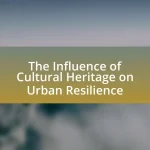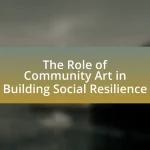Integrating urban forestry into city planning involves the strategic incorporation of trees and green spaces to enhance environmental quality, public health, and community well-being. This practice provides significant ecological benefits, such as improved air quality, reduced urban heat, and enhanced biodiversity, while also contributing to urban aesthetics and social cohesion. Key components for successful integration include stakeholder engagement, policy development, and ecological assessment, which collectively support sustainable urban forestry initiatives. Challenges such as funding limitations and public awareness are addressed, alongside best practices for maintaining urban forests and ensuring their long-term sustainability.

What is Integrating Urban Forestry into City Planning?
Integrating urban forestry into city planning involves the strategic incorporation of trees and green spaces into urban development processes to enhance environmental quality, public health, and community well-being. This practice is supported by evidence showing that urban trees can reduce air pollution by up to 30%, lower urban temperatures through shade, and improve mental health outcomes for residents. By prioritizing green infrastructure, cities can create sustainable environments that promote biodiversity and improve the overall quality of life for their inhabitants.
Why is Urban Forestry important in urban environments?
Urban forestry is important in urban environments because it enhances ecological health, improves air quality, and provides social benefits. Urban trees and green spaces contribute to biodiversity, mitigate urban heat islands, and reduce stormwater runoff, which is crucial in densely populated areas. Studies show that urban trees can lower temperatures by up to 5°F, significantly reducing energy costs for cooling. Additionally, urban forestry promotes mental well-being and community cohesion, as access to green spaces has been linked to lower stress levels and increased physical activity.
What ecological benefits does Urban Forestry provide?
Urban Forestry provides significant ecological benefits, including improved air quality, enhanced biodiversity, and effective stormwater management. Trees in urban areas absorb pollutants such as carbon dioxide, sulfur dioxide, and nitrogen oxides, leading to cleaner air; studies indicate that urban trees can remove approximately 1.7 million tons of air pollutants annually in the United States alone. Additionally, Urban Forestry supports biodiversity by providing habitats for various species, contributing to ecosystem stability; for instance, urban green spaces can host over 1,000 species of plants and animals. Furthermore, trees play a crucial role in stormwater management by intercepting rainfall and reducing runoff, which can mitigate flooding and water pollution; research shows that a mature tree can absorb up to 100 gallons of water during a single storm event.
How does Urban Forestry contribute to urban aesthetics?
Urban Forestry enhances urban aesthetics by introducing greenery, which improves visual appeal and creates a more inviting atmosphere. The presence of trees and plants can soften the harsh lines of urban architecture, provide shade, and create vibrant landscapes that attract residents and visitors. Studies have shown that areas with abundant greenery can increase property values by up to 15%, indicating a strong correlation between urban forestry and aesthetic enhancement. Additionally, urban forests contribute to biodiversity, which enriches the visual and ecological diversity of urban environments.
What are the key components of Urban Forestry integration?
The key components of Urban Forestry integration include stakeholder engagement, policy development, and ecological assessment. Stakeholder engagement involves collaboration among community members, government agencies, and organizations to ensure diverse perspectives are considered in urban forestry initiatives. Policy development establishes guidelines and regulations that support the sustainable management of urban forests, often informed by best practices and research. Ecological assessment evaluates the existing urban forest’s health, biodiversity, and ecosystem services, providing a foundation for effective planning and management. These components work together to create a cohesive strategy for integrating urban forestry into city planning, enhancing urban environments and community well-being.
What role do trees play in urban ecosystems?
Trees play a crucial role in urban ecosystems by providing environmental, social, and economic benefits. They improve air quality by absorbing pollutants and producing oxygen, which is vital for urban health. Additionally, trees mitigate urban heat through shade and evapotranspiration, reducing energy costs for cooling. Studies show that urban areas with more trees can experience temperature reductions of up to 5 degrees Fahrenheit. Furthermore, trees enhance biodiversity by providing habitats for various species, contributing to ecological balance. They also promote social well-being by offering recreational spaces and improving mental health, as evidenced by research indicating that access to green spaces can reduce stress and increase community cohesion. Overall, the integration of trees into urban planning is essential for sustainable city development.
How can green spaces be effectively incorporated into city layouts?
Green spaces can be effectively incorporated into city layouts by strategically planning their locations within urban environments to enhance accessibility and ecological benefits. Urban planners should prioritize integrating parks, green roofs, and community gardens into residential and commercial areas, ensuring that at least 10% of urban land is designated for green space, as recommended by the World Health Organization. This approach not only improves air quality and biodiversity but also promotes mental well-being among residents, as studies show that access to green spaces can reduce stress and increase physical activity levels.

How can cities effectively integrate Urban Forestry into their planning processes?
Cities can effectively integrate Urban Forestry into their planning processes by establishing comprehensive urban forestry management plans that align with land use and environmental policies. These plans should include strategies for tree planting, maintenance, and community engagement, ensuring that urban forests contribute to ecological health, climate resilience, and social well-being. For instance, the U.S. Forest Service reports that urban trees can reduce energy costs by up to 25% and improve air quality, highlighting the tangible benefits of integrating forestry into urban planning. Additionally, cities can utilize tools like GIS mapping to identify areas for tree canopy expansion and prioritize investments in underserved neighborhoods, thereby enhancing equity in urban green space distribution.
What strategies can be employed for successful integration?
Successful integration of urban forestry into city planning can be achieved through community engagement, policy development, and strategic partnerships. Community engagement ensures that local residents are involved in decision-making processes, fostering a sense of ownership and support for urban forestry initiatives. Policy development involves creating regulations and guidelines that prioritize green spaces and tree planting in urban areas, as seen in cities like Toronto, which has implemented a comprehensive urban forest management plan. Strategic partnerships with organizations, non-profits, and educational institutions can provide resources and expertise, enhancing the effectiveness of urban forestry programs. These strategies collectively contribute to the sustainable and effective integration of urban forestry into city planning.
How can stakeholder engagement enhance Urban Forestry initiatives?
Stakeholder engagement enhances Urban Forestry initiatives by fostering collaboration, ensuring diverse perspectives are considered, and increasing community support. Engaging stakeholders, such as local residents, businesses, and environmental organizations, leads to more effective planning and implementation of urban forestry projects. For instance, a study by the U.S. Forest Service found that cities with active stakeholder involvement in urban forestry programs reported higher tree survival rates and greater community satisfaction. This collaborative approach not only improves project outcomes but also builds a sense of ownership among community members, which is crucial for the long-term success of urban forestry initiatives.
What planning frameworks support Urban Forestry integration?
Planning frameworks that support Urban Forestry integration include the Urban Forest Management Plan, Comprehensive Land Use Plans, and Green Infrastructure Plans. These frameworks provide structured approaches for incorporating trees and green spaces into urban environments, enhancing ecological health and community well-being. For instance, the Urban Forest Management Plan outlines strategies for tree planting, maintenance, and community engagement, ensuring sustainable urban forestry practices. Comprehensive Land Use Plans often include policies that promote green spaces, while Green Infrastructure Plans focus on integrating natural systems into urban design to manage stormwater and improve air quality. These frameworks collectively facilitate the effective integration of urban forestry into city planning, promoting environmental sustainability and enhancing urban livability.
What challenges do cities face in integrating Urban Forestry?
Cities face several challenges in integrating Urban Forestry, including limited funding, lack of public awareness, and insufficient policy frameworks. Limited funding restricts the ability to plant and maintain trees, as urban forestry initiatives often compete with other pressing city needs. Additionally, a lack of public awareness can lead to insufficient community support and engagement, which are crucial for the success of urban forestry projects. Furthermore, insufficient policy frameworks may result in inconsistent implementation and maintenance of urban forestry practices, hindering long-term sustainability. These challenges are documented in studies such as “The Role of Urban Forestry in Sustainable Cities” by the U.S. Forest Service, which highlights the importance of financial resources, community involvement, and effective policies for successful urban forestry integration.
How can funding and resource allocation impact Urban Forestry projects?
Funding and resource allocation significantly impact Urban Forestry projects by determining the scope, quality, and sustainability of tree planting and maintenance efforts. Adequate funding allows for the hiring of skilled professionals, purchasing of high-quality saplings, and implementation of effective maintenance programs, which are essential for the long-term success of urban green spaces. For instance, a study by the U.S. Forest Service found that cities with dedicated funding for urban forestry initiatives saw a 20% increase in tree canopy cover over a decade, demonstrating the direct correlation between financial investment and project outcomes. Additionally, resource allocation influences the prioritization of areas in need of greening, ensuring that underserved communities receive equitable access to urban forestry benefits, which can enhance community health and environmental resilience.
What are common misconceptions about Urban Forestry in city planning?
Common misconceptions about Urban Forestry in city planning include the belief that trees are merely aesthetic additions rather than essential components of urban infrastructure. This misconception overlooks the fact that urban forests provide critical ecosystem services, such as improving air quality, reducing urban heat islands, and managing stormwater runoff. Additionally, some people think that urban forestry requires excessive maintenance and resources, while studies show that well-planned urban forests can be self-sustaining and cost-effective over time. Furthermore, there is a notion that urban forestry is only relevant in large cities, but research indicates that even small urban areas can benefit significantly from tree planting and management initiatives.

What are the best practices for maintaining Urban Forestry initiatives?
The best practices for maintaining Urban Forestry initiatives include regular tree health assessments, community engagement, and sustainable management practices. Regular assessments help identify diseases, pests, and structural issues, ensuring timely interventions that can prolong tree life and enhance urban canopy cover. Community engagement fosters public support and participation in tree planting and maintenance, which is crucial for the success of urban forestry programs. Sustainable management practices, such as using native species and implementing proper irrigation and mulching techniques, contribute to the resilience of urban forests against climate change and urban stressors. Studies show that cities with active urban forestry programs can increase biodiversity and improve air quality, demonstrating the effectiveness of these best practices.
How can cities ensure the sustainability of Urban Forestry efforts?
Cities can ensure the sustainability of Urban Forestry efforts by implementing comprehensive management plans that prioritize tree health, biodiversity, and community engagement. Effective management plans should include regular monitoring of tree conditions, species diversity to enhance resilience against pests and diseases, and community involvement in planting and maintenance activities. Research indicates that cities with active community participation in urban forestry programs, such as those documented in the “Urban Forests: A Global Perspective” report by the Food and Agriculture Organization, show improved tree survival rates and community satisfaction. Additionally, integrating urban forestry into city planning processes ensures that green spaces are protected and expanded in alignment with urban development, thereby promoting long-term sustainability.
What maintenance practices are essential for urban trees?
Essential maintenance practices for urban trees include regular watering, pruning, mulching, and pest management. Regular watering ensures trees receive adequate moisture, especially during dry periods, which is crucial for their growth and health. Pruning helps maintain tree structure, removes dead or diseased branches, and promotes healthy growth. Mulching conserves soil moisture, suppresses weeds, and improves soil quality, which supports tree health. Pest management involves monitoring for pests and diseases, applying treatments when necessary, and ensuring trees are healthy and resilient. These practices are supported by studies indicating that well-maintained urban trees can improve air quality, reduce urban heat, and enhance community aesthetics.
How can cities monitor the health of urban forests?
Cities can monitor the health of urban forests through a combination of remote sensing technology, ground-based assessments, and community engagement. Remote sensing, such as satellite imagery and aerial drones, allows for large-scale monitoring of tree canopy cover, species distribution, and overall forest density. Ground-based assessments involve regular inspections and health evaluations of individual trees, which can identify issues like disease, pest infestations, or structural weaknesses. Community engagement initiatives, such as citizen science programs, enable residents to report tree conditions and participate in monitoring efforts, fostering a sense of stewardship. Studies have shown that integrating these methods can lead to more effective urban forest management, as evidenced by cities like San Francisco, which utilizes a combination of these strategies to maintain its urban greenery.
What practical tips can cities implement for effective Urban Forestry integration?
Cities can implement effective Urban Forestry integration by developing comprehensive urban forestry management plans that include tree inventory, species selection, and maintenance strategies. These plans should be based on local ecological conditions and community needs, ensuring that the right trees are planted in appropriate locations to maximize benefits such as shade, air quality improvement, and biodiversity enhancement.
Additionally, cities should engage the community through educational programs and volunteer tree planting events, fostering a sense of ownership and stewardship among residents. Research indicates that community involvement can significantly increase the survival rates of newly planted trees, as seen in studies conducted by the U.S. Forest Service, which found that community-managed trees have a higher survival rate compared to those planted without local engagement.
Furthermore, cities can leverage technology by utilizing GIS mapping to track tree health and growth, allowing for data-driven decision-making in urban forestry initiatives. This approach has been validated by various urban forestry studies, which demonstrate that cities employing GIS technology can better allocate resources and prioritize areas in need of tree planting or maintenance.
How can community involvement enhance Urban Forestry initiatives?
Community involvement enhances Urban Forestry initiatives by fostering local stewardship and increasing public awareness of the benefits of trees. Engaging residents in tree planting, maintenance, and educational programs leads to a stronger sense of ownership and responsibility towards urban green spaces. Studies show that cities with active community participation in urban forestry report higher tree survival rates and improved biodiversity. For instance, a report by the U.S. Forest Service indicates that community-led tree planting efforts can increase tree canopy cover by up to 20% in urban areas, demonstrating the tangible impact of local engagement on urban forestry outcomes.
What resources are available for cities looking to improve their Urban Forestry practices?
Cities looking to improve their Urban Forestry practices can access a variety of resources, including guidelines from the U.S. Forest Service, which provides comprehensive manuals on urban forestry management. Additionally, the Arbor Day Foundation offers educational programs and grants specifically aimed at enhancing urban tree canopy and biodiversity. The National Urban Forestry Council also provides a framework for best practices and policy recommendations to support urban forestry initiatives. These resources are validated by their widespread use in successful urban forestry programs across the United States, demonstrating their effectiveness in promoting sustainable urban environments.


